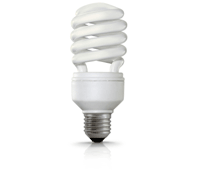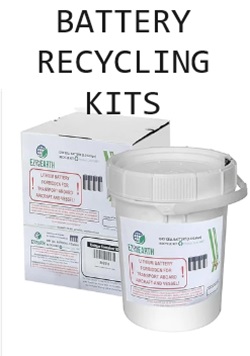
Compact fluorescent lamps (CFL's) safety is in the news again as a study funded by the U.S. National Science Foundation and published in the journal Photochemistry and Photobiology.CFL's have become very popular mainly due to their lower energy consumption (about one-fourth - 25%) for the same amount of light output compared to incandescent light bulbs. As a result, they are perceived as being "green". But, with the small amount opf mercury they contain, the risk of breakage, and now the concern that they produce UV radiation, which can cause skin cancer and age the skin, there are advantages and disadvantages, pro's and con's to using them. We will present the skin cancer / UV radiation information below, along with references to credible authoritative sources and some conclusions to help you decide when CFL's are right for you. For a primer about what CFL's are, see this page .
A study funded by the U.S. National Science Foundation and published in a recent issue of the journal Photochemistry and Photobiology found widespread chipping or cracking in the phosphor surface coating of nearly all the compact fluorescent bulbs they examined. These cracks allow UV rays to escape, which would have been absorbed by the phosphor coating and converted to safe, visible light.
As reported in many new services, including "HealthDay, "most of the bulbs 'have cracks in the phosphor coating, probably due to the fact that the coating is brittle and has trouble making the tight bends required to make these bulbs compact," explained study lead author Miriam Rafailovich, a professor of materials science and engineering and director of the Garcia Center for Polymers at Engineered Interfaces at Stony Brook University in Stony Brook, N.Y. 'As a result, we observed, by eye, defects in nearly all the bulbs that we studied." The researcher added that "skin cells exposed to [compact fluorescent light] emissions showed the same damage as those exposed to UV light" when placed close, less than one foot, to a CFL bulb.
For an explanation of UV radiation, the different types (UVA, UVB, UVC radiation), see this page from SkinCancer.org, the Skin Cancer Organization.
Each compact fluorescent bulb has a coating applied to its narrow glass tubing. The phosphor coating is absorbs the UV radiation that is produce by the bulb's source.
But the authors warn that if the bulb's surface area is riddled with "bald" spots, UV protection is lost. Many bulbs "have cracks in the phosphor coating, probably due to the fact that the coating is brittle and has trouble making the tight bends required to make these bulbs compact," according to the study's lead author Miriam Rafailovich. "As a result, we observed, by eye, defects in nearly all the bulbs that we studied."
According to HealthDay, the Stony Brook team purchased a wide array of compact fluorescent bulbs commercially available in stores across the Suffolk and Nassau county regions of Long Island, N.Y. These bulbs were the basis for their study. They measured each bulb for UV emissions and examined the bulbs for signs of cracking in its phosphor coating, correlating the two measurements and observations.
They concluded that all the bulbs, regardless of manufacturer or brand, emitted significant levels of both ultraviloet radiation in both the UVC and UVA wavelengths and that this leakage was due to cracks in their phosphor coatings.
The report says that the team conducted studies to examine
the effects upon healthy human skin cellsand concluded that damage was
caused, which was "consistent" with the damage typically caused by UV radiation from the sun.
It should be noted that incandescent bulbs of similar strength do not
produce UV radiation in a amount that produces skin cell damage.
Before you panic, you must understand that UV radiation and the damages from it follow the "inverse square law" relative to the distance from the bulb. In other words, as you move away from the bulb, the risk declines quickly, by 1/x2. So, here are the recommendations:
As much as you can, relocate your existing CFL bulbs to locations farthest away from human beings. For example, outdoor floodlamps are a great use for the outdoor type of CFL's Similarly, recessed ceiling lights, overhead ceiling lights are also safe uses. And in these locations, the chances of break are almost zero.
Put CFL bulbs in fixtures that have a lamp shade or glass cover between the bulb and any nearby people. The shade and covers will absorb the UV radiation, or substantialy diminish it.
If you cannot move or cover them, try to position the lamps so they are at least 2 feet away from people.
Replace bulbs which are close to people with LED bulbs. In addition to not emitting UV radiation and containing no mercury, they last longer and use even less energy, too.
Finally, as unbelievable as this recommendation may first sound, wear sunscreen every day. Dermatologists recommend that everyone should wear sunscreen every day, all year round, as even brief exposures can cause sun damage over time. And ladies, the UVA radiation which ages the skin goes right through glass windows, like those in your car!
 <
<
Ways to save money AND help the environment:
Eat healthier AND save money: Instant Pot Duo Crisp 11-in-1 Air Fryer and Electric Pressure Cooker Combo with Multicooker Lids that Fries, Steams, Slow Cooks, Sautés, Dehydrates
Save water AND money with this showerhead adapter, it lets the water flow until the water is hot, then shuts off water flow until you restart it, ShowerStart TSV Hot Water Standby Adapter
Protect your health with these:
Mattress Dust mite-Bedbug protector, 100% Waterproof, Hypoallergenic, Zippered
Handheld Allergen Vacuum Cleaner with UV Sanitizing and Heating for Allergies and Pet, Kills Mite, Virus, Molds, True HEPA with Powerful Suction removes Hair, Dander, Pollen, Dust,
Immune Support Supplement with Quercetin, Vitamin C, Zinc, Vitamin D3
GermGuardian Air Purifier with UV-C Light and HEPA 13 Filter, Removes 99.97% of Pollutants
5 Stage Air Purifier, Features Ultraviolet Light (UVC), H13 True Hepa, Carbon, PCO, Smart Wifi, Auto Mode, Quiet, Removes 99.97% of Particles, Smoke, Mold, Pet Dander, Dust, Odors
Interesting Reads:
THE PREPPER'S CANNING & PRESERVING BIBLE: [13 in 1] Your Path to Food Self-Sufficiency. Canning, Dehydrating, Fermenting, Pickling & More, Plus The Food Preservation Calendar for a Sustainable Pantry
The Backyard Homestead: Produce all the food you need on just a quarter acre! Paperback
The Citizens' Guide to Geologic Hazards: A Guide to Understanding Geologic Hazards Including Asbestos, Radon, Swelling Soils, Earthquakes, Volcanoes
The Uninhabitable Earth: Life After Warming
Book: The Sixth Extinction: An Unnatural History Paperback